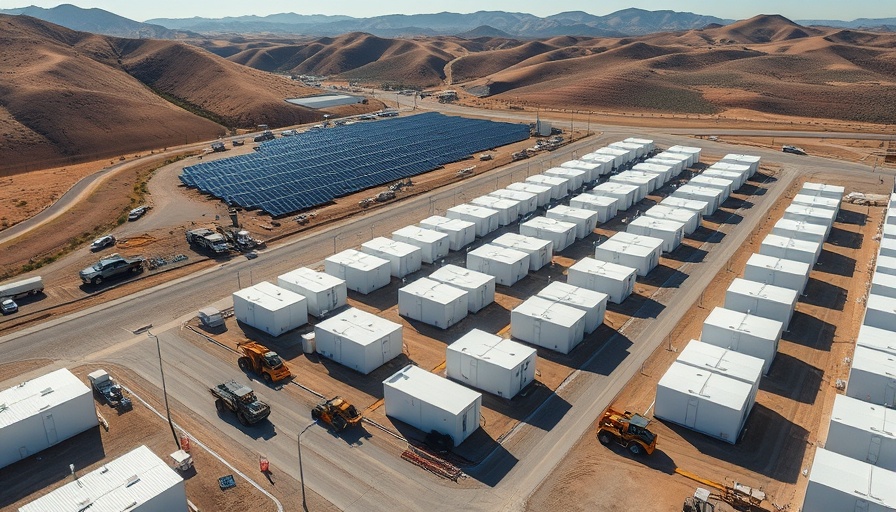
California's Renewable Revolution: Adding Solar-Battery Capacity
As California strives for a greener future, the addition of 1.35 gigawatts (GW) of solar-battery capacity to the state’s energy grid marks a significant enhancement in its renewable energy infrastructure. This expansion isn't merely a number; it represents a crucial shift towards sustainability, enabling the state to better harness solar power, especially during peak demand times.
The Projects Behind the Numbers: A Closer Look
The two new projects that contribute to this substantial capacity increase are set in regions known for their abundant sunshine. By pairing solar energy with battery storage systems, these projects allow excess energy generated during the day to be stored and used when demand peaks, such as in the evenings. This is an innovative solution that aligns perfectly with California's commitment to renewable energy and reflects a growing trend nationwide.
Societal Impact: Empowering Communities Through Clean Energy
The significance of these solar-battery projects extends beyond mere numbers and infrastructure. By investing in renewable energy, California is paving the way for cleaner air and less dependence on fossil fuels, directly impacting public health. Communities near these projects may benefit not only from a more stable energy supply but also from job opportunities as construction and operational jobs emerge.
Parallel Examples: Lessons from Global Energy Leaders
California is not alone in its pursuits. Countries like Germany and China have made marked advances in solar energy and battery storage, serving as excellent case studies. Germany, for instance, has successfully integrated renewable energy into its grid to such an extent that it often runs on over 70% renewable energy during peak production times. Learning from such models could help Californian officials and energy providers address potential challenges head-on.
Future Predictions: What Lies Ahead for California's Energy Landscape?
Looking towards the future, these projects could serve as stepping stones toward even greater integration of renewable resources. Experts speculate that as battery technology continues to evolve, costs will drop, and efficiency will increase, meaning homeowners and businesses could rely more heavily on solar energy. This trajectory aligns perfectly with California’s ambitious goal to achieve 100% clean, renewable energy by 2045.
Counterarguments: The Complexity of Energy Transition
While the optimism surrounding solar-battery projects is palpable, it’s essential to recognize the potential drawbacks. Some critics argue that large-scale solar installations could impact local ecosystems and biodiversity and raise questions about land use. Balancing renewable energy development with environmental stewardship remains a challenge dynamically shaping Californians’ conversations about energy.
Talking Points: Relevance to Current Events
The push for solar energy storage is particularly relevant amidst the ongoing discussions about climate change and energy independence. With natural disasters increasingly disrupting traditional energy supplies, ensuring stability through renewable resources will only become more critical in the wake of climate-related events.
Unique Benefits of Electric Storage: A New Era of Energy
The unique benefits of adding battery storage to the energy mix are undeniable. These systems not only provide reliability during outages but can also serve as a buffer against price fluctuations, effectively helping customers save money over time. For homeowners and small businesses, understanding this technology's potential could be a game-changer.
Making Informed Decisions: What Homeowners Should Know
As these solar-battery projects roll out, homeowners and home service contractors must stay informed. Understanding how to integrate solar solutions into homes can provide significant long-term benefits, including reduced energy costs and increased property values. Encouraging local contractors to become familiar with these technologies can facilitate a smoother transition for homeowners.
Actionable Insights: Embrace Renewable Energy Today!
For those interested in adopting solar energy, now is a fantastic time. Research local incentives and rebates for solar installations and connect with contractors specializing in solar integration. As California takes significant strides toward a sustainable future, individuals can participate in this journey by exploring options for renewable energy in their homes.
California is leading the charge towards a cleaner, more sustainable energy future, and every resident can play a part in this transition. Embrace solar energy, consult with experts, and contribute to a greener tomorrow!
 Add Row
Add Row  Add
Add 




Write A Comment